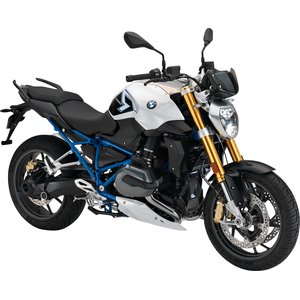BMW R 1200 R (2013-2018): The Boxer-Powered Roadster That Redefines Versatility
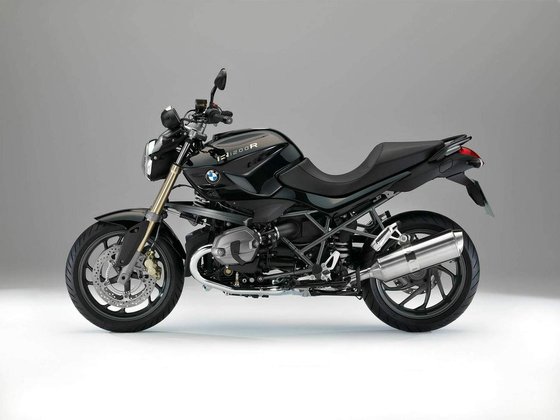
Introduction
The BMW R 1200 R stands as a testament to the German manufacturer’s ability to blend heritage with innovation. Produced from 2013 to 2018, this generation of the R 1200 R refined the concept of a "do-it-all" roadster, combining the iconic boxer engine with modern chassis dynamics and rider-focused technology. Whether carving canyon roads, commuting through city traffic, or embarking on weekend tours, this motorcycle delivers a uniquely balanced experience. Let’s dive into what makes this machine a standout in BMW’s lineup and the naked bike segment.
Design & Ergonomics
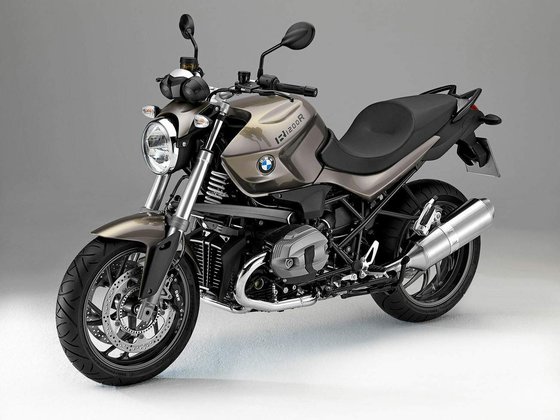
The R 1200 R’s design philosophy revolves around muscular minimalism. Its compact bodywork, exposed engine, and sharp tank lines give it a purposeful, aggressive stance. The 2015 refresh introduced a USD fork (borrowed from the S 1000 RR) that added a sportier aesthetic, while variants like the DarkWhite Special Edition (2013) and 90 Years Anniversary Model (2014) showcased blacked-out components or retro-inspired finishes.
With a 790 mm seat height (31.1 inches), the bike accommodates riders of varying statures. The upright riding position strikes a perfect balance between sporty lean and touring comfort. Wide handlebars offer leverage for precise control, while the sculpted seat—available in multiple heights—ensures long-haul comfort. The 18-liter fuel tank (4.76 US gallons) is slim between the knees, enhancing rider connection without sacrificing range.
Engine & Performance
The Heart of the Beast
At its core lies the air/liquid-cooled 1170cc boxer twin, producing 125 HP (92 kW) @ 7,750 RPM and 125 Nm (92 lb-ft) @ 6,500 RPM. This engine is a masterpiece of flexibility:
- Low-end grunt: Torque kicks in as early as 2,000 RPM, making city riding effortless.
- Mid-range punch: The 6,000–7,500 RPM range delivers exhilarating acceleration for overtakes.
- Top-end refinement: Despite its 220 km/h (137 mph) top speed, vibrations remain well-controlled.
The switch to electronic throttle control (ride-by-wire) in 2015 unlocked features like Riding Modes Pro (Rain, Road, Dynamic) and Dynamic Traction Control (DTC), allowing riders to tailor power delivery to conditions.
Fuel Efficiency & Range
With an average consumption of 4.1–4.9 L/100 km (57–48 MPG), the R 1200 R offers a 330–400 km (205–250 miles) range—a practical companion for both daily rides and adventures.
Handling & Dynamics
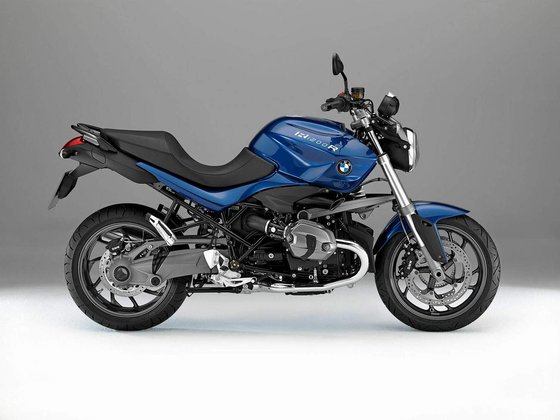
Chassis & Suspension
The R 1200 R’s Telescopic USD fork (45 mm stanchions) and Paralever rear suspension provide a plush yet communicative ride. The front suspension’s 140 mm (5.5 inches) of travel absorbs bumps without wallowing, while the rear’s hydraulically adjustable preload simplifies setup for solo or two-up riding.
Key geometry figures:
- Wheelbase: 1,515 mm (59.6 inches)
- Rake: 27.7°
- Trail: 126 mm (4.9 inches)
These numbers translate to agility in corners and stability at speed. The 231 kg (509 lbs) wet weight feels lighter than it looks, thanks to the low center of gravity from the boxer layout.
Brakes & Tires
Dual 320 mm front discs with 4-piston calipers and a 265 mm rear disc deliver strong, predictable stopping power. ABS (switchable on later models) adds confidence in wet conditions. The stock 120/70-17 front and 180/55-17 rear tires (often Metzeler Roadtec or Michelin Pilot Road) strike a balance between grip and longevity.
Technology & Features
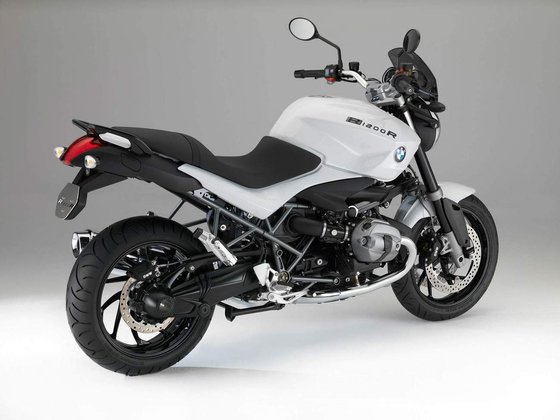
While not overloaded with gadgets, the R 1200 R includes thoughtful tech:
- Digital-analog instrument cluster: Combines a tachometer with an LCD screen for gear position, fuel range, and trip data.
- Optional Dynamic ESA: Electronically adjusts damping for road conditions.
- LED lighting (2015+): Improves visibility and modernizes the design.
- Keyless Ride (2017+): Adds convenience for ignition and fuel cap access.
Competition
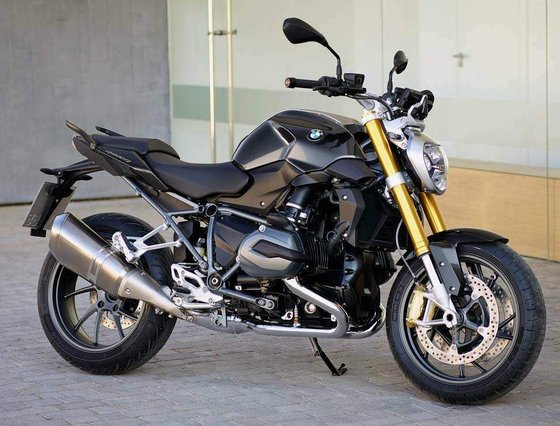
How does the R 1200 R stack up against rivals in the liter-class naked segment?
1. Ducati Monster 1200
- Pros: Higher peak power (150 HP), sharper styling, cornering ABS.
- Cons: Less low-end torque, higher seat height (820 mm), pricier maintenance.
- Verdict: The Monster appeals to thrill-seekers, while the BMW prioritizes versatility.
2. Yamaha MT-09
- Pros: Lighter (193 kg), cheaper, aggressive triple-cylinder character.
- Cons: Less refined suspension, buzzy at high RPMs, basic electronics.
- Verdict: A budget-friendly alternative but lacks the BMW’s polish.
3. Triumph Speed Triple
- Pros: 1,050cc triple engine, premium components, sharper handling.
- Cons: Stiffer ride, higher fuel consumption, shorter range.
- Verdict: The Triumph is sportier; the BMW is more relaxed.
4. Honda CB1000R
- Pros: Sleek neo-retro design, smooth inline-four engine.
- Cons: Less torque below 6,000 RPM, higher insurance costs.
- Verdict: The Honda excels in style, but the BMW’s boxer charm is irreplaceable.
Maintenance
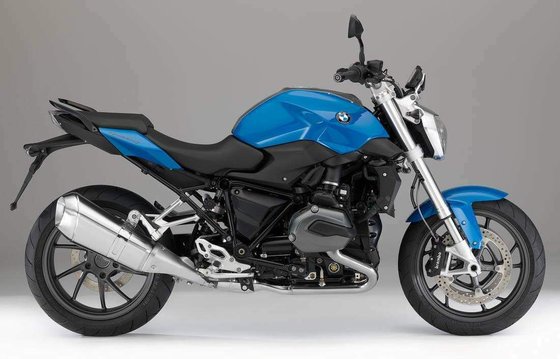
The R 1200 R’s shaft drive reduces chain maintenance, but key service points include:
1. Oil Changes
- Interval: Every 10,000 km (6,200 miles)
- Oil type: SAE 5W-40 (4.0 liters with filter)
- Pro tip: Use BMW-approved oil to protect the dry-sump system.
2. Valve Adjustments
- Interval: Every 20,000 km (12,400 miles)
- Specs:
- Intake: 0.10–0.17 mm (0.004–0.007 in)
- Exhaust: 0.34–0.41 mm (0.013–0.016 in)
3. Brake Fluid & Coolant
- Brake fluid: Replace DOT 4 every 2 years.
- Coolant: Use silicate-free fluid; capacity ~1.5 liters.
4. Shaft Drive Maintenance
- Final drive oil: 75W-90 GL-5 (180 ml) every 20,000 km.
5. Tire Pressure
- Front: 2.5 bar (36 psi)
- Rear: 2.9 bar (42 psi)
Recommended Upgrades from MOTOPARTS.store
- Performance spark plugs: NGK LMAR8D-J (gap 0.7–0.9 mm).
- High-flow air filters: Improve throttle response.
- Adjustable levers: Customize reach for smaller hands.
- Crash bars: Protect the engine during low-speed drops.
Conclusion
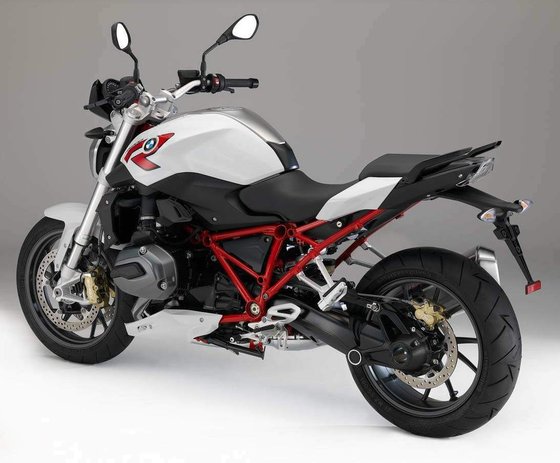
The BMW R 1200 R (2013–2018) remains a compelling choice for riders seeking a blend of character, comfort, and capability. Its boxer engine delivers a unique combination of tractable power and mechanical charm, while the chassis balances sportiness with all-day usability. Though newer models have eclipsed it in tech, this generation’s simplicity and reliability make it a smart buy for enthusiasts who value substance over trends.
Whether you’re refreshing your R 1200 R with OEM parts or upgrading its performance, MOTOPARTS.store offers everything from valve shim kits to premium oils—ensuring your boxer-powered roadster stays in peak condition for years to come.
















Specifications sheet
| Engine | |
|---|---|
| Stroke: | Four-stroke |
| Max power: | 92 kW | 123.0 hp |
| Max torque: | 125 Nm |
| Fuel system: | Electronic fuel injection (ride-by-wire) |
| Max power @: | 7750 rpm |
| Displacement: | 1170 ccm |
| Fuel control: | Double Overhead Cams (DOHC) |
| Max torque @: | 6500 rpm |
| Bore x Stroke: | 101.0 x 73.0 mm |
| Configuration: | Oposite |
| Cooling system: | Liquid/Air |
| Compression ratio: | 12.5:1 |
| Number of cylinders: | 2 |
| Dimensions | |
|---|---|
| Wheelbase: | 1515 mm (59.6 in) |
| Dry weight: | 198 |
| Wet weight: | 231 |
| Seat height: | 790–820 mm (31.1–32.3 in) adjustable |
| Overall width: | 880 mm (34.6 in) |
| Overall height: | 1300 mm (51.2 in) |
| Overall length: | 2165 mm (85.2 in) |
| Ground clearance: | 165 mm (6.5 in) |
| Fuel tank capacity: | 18 L (4.76 US gal) |
| Drivetrain | |
|---|---|
| Final drive: | shaft |
| Gear ratios: | 1st 2.375, 2nd 1.696, 3rd 1.296, 4th 1.065, 5th 0.939, 6th 0.848 |
| Transmission: | 6-speed constant mesh |
| Maintenance | |
|---|---|
| Engine oil: | SAE 5W-40 |
| Brake fluid: | DOT 4 |
| Spark plugs: | NGK LMAR8D-J |
| Spark plug gap: | 0.8 |
| Final drive oil: | 180 ml 75W-90 GL-5 |
| Coolant capacity: | 1.5 |
| Forks oil capacity: | 1.18 |
| Engine oil capacity: | 4.0 |
| Engine oil change interval: | Every 10,000 km or 1 year |
| Valve clearance (intake, cold): | 0.10–0.17 mm |
| Valve clearance check interval: | 24,000 km (15,000 mi) |
| Valve clearance (exhaust, cold): | 0.34–0.41 mm |
| Recommended tire pressure (rear): | 2.9 bar (42 psi) |
| Recommended tire pressure (front): | 2.5 bar (36 psi) |
| Additional Features | |
|---|---|
| ABS: | BMW Motorrad Integral ABS (disengageable) |
| Riding modes: | Rain, Road, Dynamic (optional Pro modes) |
| Traction control: | Dynamic Traction Control (DTC) |
| Chassis and Suspension | |
|---|---|
| Frame: | Two-section frame with load-bearing engine |
| Rear tire: | 180/55-z-17 |
| Front tire: | 120/70-z-17 |
| Rear brakes: | 1 x 275 mm disc, 2-piston caliper (ABS Pro) |
| Front brakes: | 2 x 320 mm discs, 4-piston radial calipers (ABS Pro) |
| Rear suspension: | Paralever single-sided swingarm, hydraulically adjustable preload and rebound damping, 140 mm travel |
| Front suspension: | Upside-down telescopic fork, 45 mm stanchions, 140 mm travel |



